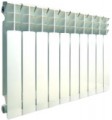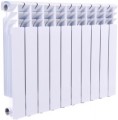Heat output
The rated thermal output of the radiator is the amount of heat given off to the air in normal operation.
When choosing this parameter note that the heat output will depend on the temperature difference at the inlet and outlet to the radiator, as well as on the ambient temperature. The greater the temperature difference and the colder it is around, the more intense the heating will be. Therefore, in the specs, it is customary to indicate heat transfer for certain standard conditions. In particular, the designation according to the European standard EN-442 is very popular, which assumes heating medium temperatures of +75 °С and +65 °С at the inlet and outlet, respectively, as well as an air temperature of +20 °С. Real conditions and the actual heat output of the radiator may differ; therefore, when choosing, it is best to choose a model with a certain margin and compensate for excess power with one or another regulator. As for the actual values, in the most modest models, the heat output
does not exceed 750 W, or even
500 W, and in the largest, this figure can reach
3.5 – 4 kW or
more.
The choice for this parameter depends primarily on the size and specs of the heated space. The simplest calculation formula is as follows: at least 100 W of thermal power is required per 1 m2 of area. This formula is relevant for standard r
...esidential/office premises with ceilings of 2.5 – 3 m, without problems with thermal insulation; for more specific conditions, there are more detailed calculation methods, that can be found in special sources.Radiator height
Radiator height. The most widespread nowadays are standard height sizes:
30 cm,
40 cm,
50 cm,
60 cm and
90 cm. In addition, you can find other options (although much less often) —
20 cm,
45 cm,
55 cm,
70 cm,
75 cm and
80 cm.
Firstly, the height of the product primarily determines the size of the space required for installation. At the same time, for models placed in a niche (see "Mounting"), this dimension actually corresponds to the required depth of this niche. In other cases, it is worth taking a certain margin in height — the radiator cannot be installed close to the floor and window sill (or other similar items). And models with a bottom connection (see above) will require additional space for the pipe connection.
Secondly, this size determines heat output: all other things being equal (including the size in width), a higher radiator will have a larger working surface area and a higher heat output (this is also true for heat exchangers in convectors). Thus, modern radiators are traditionally produced not in separate models, but in series of the same type of devices that differ onl
...y in size and thermal power.Radiator depth
The size of the radiator from the front to the back wall.
This parameter determines both the size of the space occupied by the device and its efficiency: other things being equal, a greater depth means a higher heat output (due to an increase in the area of contact with air). Specific nuances depend on the type of radiator and the method of its installation (see above). So, the most critical depth is for convectors with a horizontal layout, mounted in a niche — in them, this size directly determines both the required dimensions of the niche and the area of the working surface. In column models, this dependence is somewhat less pronounced. In panel devices, the efficiency depends not so much on the depth as such, but on the number of working elements (see "Type (panel)") — although a larger number of panels/convectors inevitably affects the dimensions. And sectional radiators most often have a relatively small depth: the differences between them in this parameter are not fundamental.

